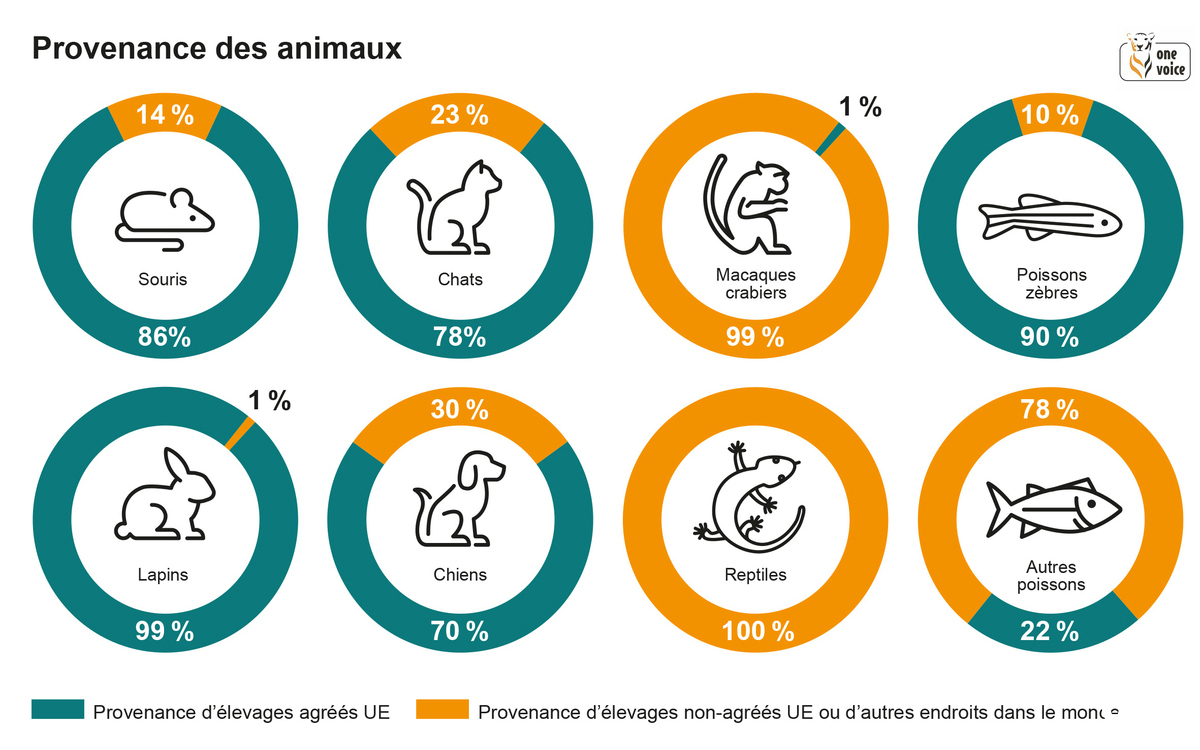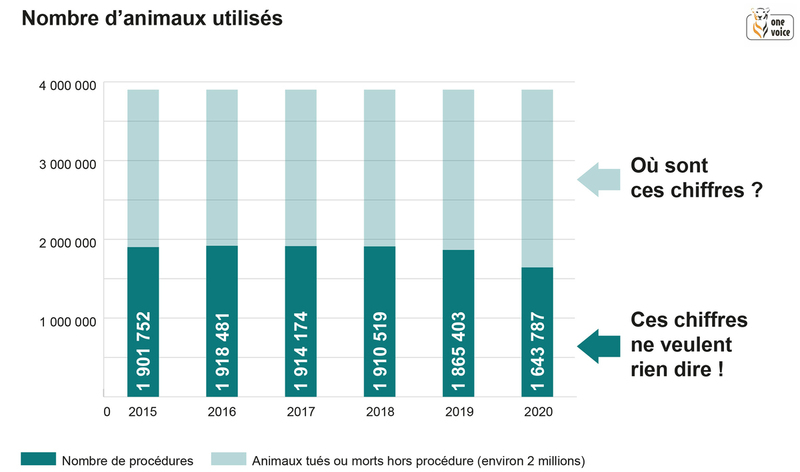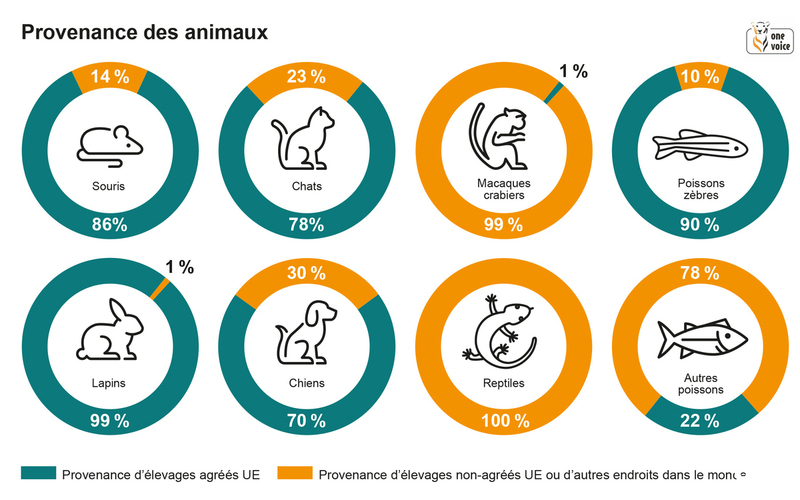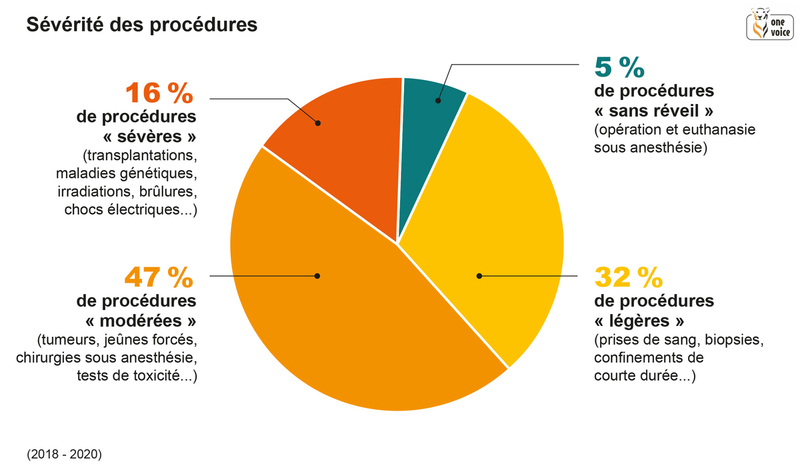
A few less animals in labs in 2020?
The figures from 2020 on animal testing have just come out. Spoiler: the situation is not improving… we can tell you everything.
Every year, we wait for the figures on animal testing and every year they are disappointing. Between the animals forgotten by the statistics, the absence of the development of practices, and the representation of suffering and deaths on the charts devoid of any emotion, we can clearly see that the fight is far from being won.
The figures on animal testing still always arrive very late in France. At the end of February 2022, we have just found out those from 2020. We will be told that it is two months earlier than in 2019 (when we had to wait until the end of April and for a complaint from us alongside Europe against France to have the figures from 2017) and four months earlier than in 2020 (with the publication of the figures for 2018 at the end of June). If this ‘statistical study’ was complete, well presented, and accompanied with relevant details as it is in England, we could forgive the lateness. But when we find ourselves faced with a document a few pages long that forgets to indicate where the primates used come from and which does not establish any comparison with the previous years, we can say that ‘transparency’, which has recently become a recurring theme in defending animal testing, is really only smoke and mirrors.
Figures are going down… on paper
The study brings good news when it comes to the number of animals used, since it is less than 200,000 than the number calculated for 2019 — but the Ministry itself recognises in the document that “this reduction is explained in part by the COVID-19 epidemic which led to a suspension of activity in some establishments”. Good news in this case? Not really: since May 2020, a researcher mentioned on the radio the “sacrifice” of thousands of animals in laboratories “since we no longer have the possibility for staff to come and take care of them”. OPAL, an association of animal testing professionals, also published directives showing absence thresholds from which to plan for euthanasia procedures (15% absent), to start euthanising (40% absent), or to mass euthanise the animals (60-75% absent).
If you still need to be reminded, the figures provided by the Ministry do not show the number of individuals used and/or killed, but the number of procedures. Euthanasia itself is not considered a procedure; the animals killed as a result of a loss of staff are not counted in the study. We have therefore already reported this bad practice in statistical study regarding animals killed to take their tissue or to manage the surplus of animals, insofar as this allows an artificial reduction of the figures to half the amount. The reduction in figures in the study therefore does not mean that less animals died in laboratories in 2020, but simply that there were less experiments.

In short: experiment species and purposes
As usual, rodents, fish, and rabbits form the vast majority of animals used in 2020. But there are still dogs, cats, primates, ferrets, cows, pigs, equine animals, birds, cephalopods, reptiles, amphibians… separately to the great apes (for whom, on the face of it, no exemption has been given in the last few years in France); very few species completely escape animal testing.
As for the purpose of the experiments, it has not changed. Around 90% of them are divided between essential research, applied research, and toxicology studies, in a varied way according to the species: the reptiles, cephalopods, some rodents, goats, and prosimians are almost all used for essential research; the rabbits, dogs, guinea pigs, and crab-eating macaques are mainly used to test the toxicity of medicines for humans, while cats and some birds mainly serve to test veterinary products.
Do the animals all come from approved farms?
For years, we have been told over and over again that the animals must come from specialised and approved farms specifically for animal testing – as if this justifies animal testing! However, only 82-83% of animals come from these farms in the last few years, and this figure is considerably variable according to species. We have seen in particular that 30% of dogs and 21% of cats used for the first time in 2020 did not even come from unapproved European farms, but from farms situated elsewhere in the world, on which it would be difficult to obtain information. Another fine example of transparency on which we never hear animal testing supporters express themselves.
The situation for crab-eating macaques (also called long-tailed macaques or cynomolgus macaques) is less desirable still. With several thousands of procedures each year, these are the primates most used in the experiments. However, the Ministry did not deign to inform us in the 2019 and 2020 studies about where these animals came from. If we are to believe the previous years’ studies, the crab-eating macaques mainly come from countries outside of Europe – which hardly surprises us seeing as we have reported for a long time on farms in Mauritius which regularly replenish their wild animals, and more recently on capturing wild primates in Indonesia, mainly destined for the United States and China (whose farms can also supply the primates used in France).
The report written by the European Commission in 2017 mentioned that, according to the results from the feasibility study carried out in previous years, all of the primates used from November 2022 would come from at least the second generation in captivity (‘F2’ primates[1]) – with the exception of studies involving old primates, who could use ageing F1 primates. We wonder how France will be able to reach this goal when we note that out of 66.9% of F2 primates in 2018, the figure went to 66% in 2019 before going back up slightly to 69% in 2020. This shows that almost 30% of primates used in 2020 were from the first generation in captivity. In other words, their relatives were captured in the wild. According to the report by the European Commission, it is mainly about crab-eating macaques – which brings us back once again to farms in Mauritius and to the captures in Indonesia…
[1] Primates used in laboratories are listed in three categories: ‘autonomous colonies’ (who do not buy primates externally and therefore the renewal of individuals is done by reproduction within the colony), ‘F1’ primates (first generation in captivity, meaning that their relatives have been captured in the wild) and ‘F2’ primates (second generation or more in captivity, meaning that their relatives are F1 primates). After the second generation, we talk about ‘F2+’ primates.

Those that we do not talk about
Alongside these animals that we often talk about, we rarely hear people talking about the species referred to as ‘other mammals’, ‘other carnivores’, or ‘other birds’ in the statistical survey. Taking a closer look using the detailed figures (obtained on request from the Ministry), we can see that these species are mainly used in ethology and animal biology when it comes to roe deer, wild boars, deer, seals, whales, dolphins, many birds, and some species of rodent – with procedures involving stress or pain at least equivalent to a needle being inserted, since they are recorded as animal testing. As for the ‘other birds’, they gather many ducks, geese, turkeys… who are subjected to experiments aiming to improve the productivity of their species for human consumption (particularly in the foie gras industry) among other things.
Let’s also not forget the cases where the ‘unauthorised farms’ in the European Union are zoos — One Voice had already passed on the warning of a German association in 2014, which reported on the experiments being carried out on primates born in French zoos near Nantes. Incidentally, the Ministry statistics for 2018 explicitly mention “zoological parks” as being the origin of the dogfish. Not to mention the National Natural History Museum, which we have recently reported on for breeding hundreds of adorable mouse lemurs for research. Again, with this single mention in fine print in a vague document, we cannot really talk about transparency: how can you know whether zoos near to where you live are providing animals to laboratories?
Year after year, suffering persists
We come to the most serious thing at the heart of rejecting animal testing: animals suffering. We talk about ‘refining’ experiments and the conditions they are kept in, but it is still a question of putting mice in plastic boxes, dogs in stalls, rabbits in cages, which they only get out of to be subjected to the experiments for which they are intended.
And these experiments are far from being harmless: in 2020, almost 225,000 ‘severe’ procedures were carried out. The regulations maintain that these procedures are likely to cause “pain, suffering, or intense anxiety, or pain, suffering, and moderate long-term anxiety” for the animals or “to have a serious negative impact on the well-being or general state of the animals”. These are transplants, caused or facilitated genetic diseases, irradiation and other burns, electric shocks that the animals cannot escape…
Since 2016, severe procedures represent around 15% of experiments carried out in France, without an indicative decrease. Although cats and dogs are proportionately less involved, some do not escape it: 118 dogs and 27 cats were subjected to these procedures in 2020. The number of animals bred to show harmful genetic modifications has been increasing since 2016, reaching almost 84,000 animals in 2020 – it mainly involved mice, but also rats, dogs, and zebrafish.
Almost 50% of the procedures are “moderate”, meaning that they are likely to cause “pain, suffering, or intense anxiety, or pain, suffering, and moderate short-term anxiety, or pain, suffering or minor long-term anxiety”, or “to have a moderate negative impact on the well-being or general state of the animals”. It can be a question of inducing tumours, forced fasting, surgery under anaesthetic, toxicity tests, certain genetic modifications, and so forth…. This figure increases slightly every year at the expense of ‘light’ procedures (30%) such as taking blood, biopsies, or short quarantining in metabolic cages. In fact, beyond the light procedures that animal testing defenders like to showcase, 65% of the experiments involve suffering that is far from being negligible.

What can we learn?
Animal testing is an injustice which we must put an end to. Those who defend it mask their victims behind figures, percentages, and charts. They try to make us believe that these animals are being used for a good common service, all while denying public opinion and trying to influence it when it is not in their favour. Yet it is the general public who funds the majority of these research centres. It is the general public that the results are meant to benefit.
Finally, the figures from 2020 reveal above all that this moral aberration that is animal testing continues and that we will still have to fight to get away from it – by demanding investments in the development of non-animal methods, by demanding a strict obligation to research and apply these methods as soon as they exist, and, on an individual level, by supporting the European Citizens’ Initiative that asks for a strict ban on testing cosmetic ingredients on animals.
Translated from the French by Joely Justice